Engage NY Eureka Math 7th Grade Module 2 Lesson 20 Answer Key
Eureka Math Grade 7 Module 2 Lesson 20 Task Answer Key
TASK: Using the above information, semiannual statements, register, and beginning balance, do the following:
1. Record the beginning balance and all transactions from the account statements into the register.
2. Determine the annual gain or loss as well as the overall 5-year gain or loss.
3. Determine if there is enough money in the account after 5 years to cover $30,000 of college expenses for Justin and Adrienne’s daughter. Write a summary to defend your answer. Be sure to indicate how much money is in excess, or the shortage that exists.
4. Answer the related questions that follow.
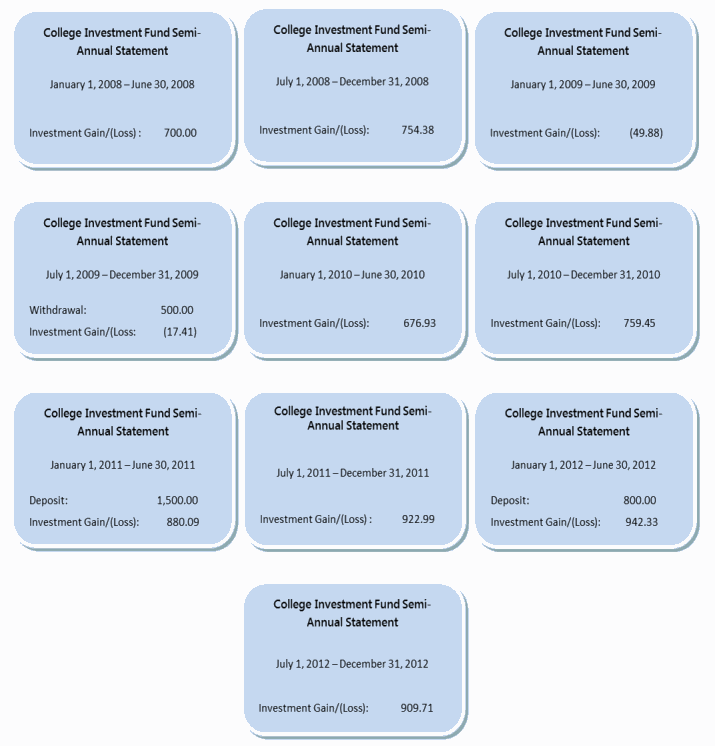
Answer:

Question 5.
Register
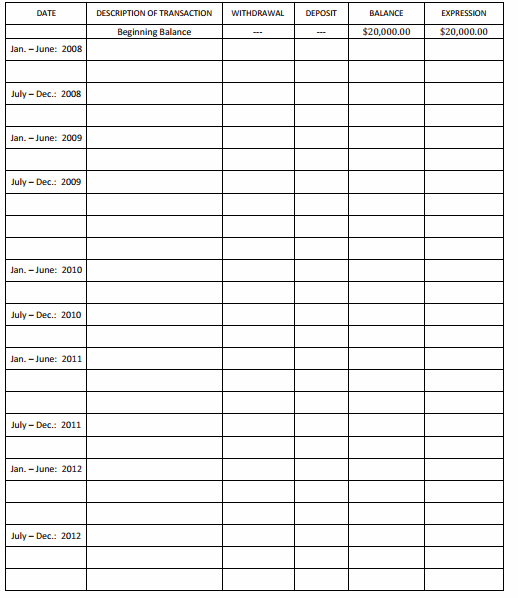
Answer:
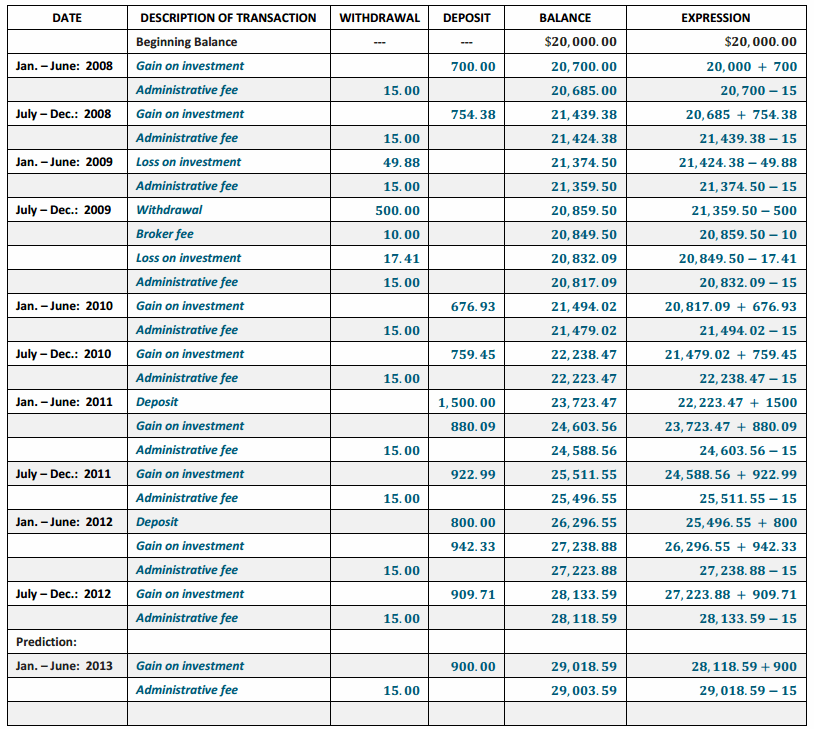
→ Describe the process of completing the register.
→ Starting with the beginning balance, fill in the description of the transaction and the amount. If the transaction is an investment loss,
withdrawal, or fee, then the amount is recorded in the payment column. If the transaction is an investment gain or deposit, then the amount is recorded in the deposit column. To obtain the new balance, subtract the payment amount, or add the deposit amount, from the balance on the preceding line. Record the new balance, and use that balance to complete the next line.
→ Describe how to find the broker’s fee.
→ The broker’s fee is 2% of the transaction amount. To find the broker’s fee, you must first find the total
of the transaction amount. Once you have that, write the percent as a fraction out of 100 and multiply
the fraction by the transaction amount. This result is the amount of the broker’s fee, which is then
subtracted from the preceding balance.
Example: 2% of $2,500
\(\frac{2}{100}\) × 2,500 = \(\frac{1}{50}\) × 2,500 = 50
→ Compare your register with the person next to you. Did each of you list the transactions in the same order?
Does it make a difference?
→ The order is probably not the same. The order of the transactions for each 6-month period does not
make a difference.
→ Continue to compare your registers. Do you both get the same balance at the end of 2012? If not, switch papers and check to see if you can find your neighbor’s mistake.
Question 6.
Annual Gain/Loss Summary
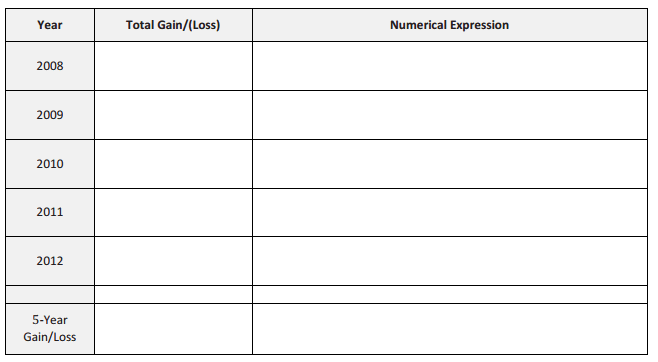
Answer:
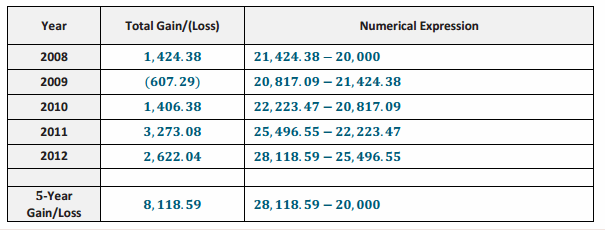
Question 7.
Summary
Answer:
There is not enough money in the account at the end of 5 years to cover the college expenses, but it is close. They needed at least $30,000 in the account to cover the expenses, and there was $28,118.59, leaving a shortage of $1,881.41.
Question 8.
Related Questions
a. For the first half of 2009, there was a $700 gain on the initial investment of $20,000. Represent the gain as a percentage of the initial investment.
Answer:
\(\frac{x}{100}\) =700/(20,000) The gain was 3.5% of $20,000.
b. Based on the gains and losses on their investment during this 5-year period, over what period of time was their investment not doing well? How do you know? What factors might contribute to this?
Answer:
The investment was not doing well in 2009. There were losses on the investment for both halves of the year, and $500 was taken out of the account. It could be because the economy was doing badly, and a recession affected the investment’s performance.
c. In math class, Jaheim and Frank were working on finding the total amount of the investment after 5 years. As a final step, Jaheim subtracted $150 for administrative fees from the balance he arrived at after adding in all the deposits and subtracting out the one withdrawal and broker’s fee. For every semiannual statement, Frank subtracted $15 from the account balance for the administrative fee. Both boys arrived at the same ending 5-year balance. How is this possible? Explain.
Answer:
Jaheim took the $15 fee and multiplied it by 10, since there were 10 statements, and deducted the $150 total. Frank subtracted $15 from the account balance for each statement. That was 10 times. So, both ways produce the same result: reducing the account balance by $150 overall.
d. Based on the past statements for their investment account, predict what activity you might expect to see on Adrienne and Justin’s January–June 2013 account statement. Then record it in the register to arrive at the balance as of June 30, 2013.
Answer:
I predict the account will continue to produce gains. The gains have been around $900 for the past four statements, so I predict it will be about $900 again, since it decreased by a little bit the last time, and there was a $909.71 gain the last time. If I take away $15 for the administrative fee, the balance would go up by $885, and it would be $29,003.59.
e. Using the answer from part (d), if their daughter’s college bill is due in September of 2013, how much money do you estimate will be in their investment account at the end of August 2013 before the college bill is paid? Support your answer.
Answer:
Their investment could gain more money for July and August. Right now, it is gaining about $900 per statement. If I divide that by 6, it equals $150 (which is the average gain per month). So, for July and August I estimate that it will earn about another $300 (including the $15 fee), so there might be $29,333.59 in the account.
Eureka Math Grade 7 Module 2 Lesson 20 Exercise Answer Key
Below is a transaction log of a business entertainment account. The transactions are completed, and the ending balance in the account is $525.55. Determine the beginning balance.

Answer:

Eureka Math Grade 7 Module 2 Lesson 20 Exit Ticket Answer Key
Question 1.
Using the incomplete register below, work forward and backward to determine the beginning and ending balances after the series of transactions listed.

Answer:

Question 2.
Write an expression to represent the balance after the paycheck was deposited on 1/31/12. Let x represent the beginning balance.
Answer:
x+350.55
Question 3.
Write a numerical expression to represent the balance after the transaction for Main Street Jeweler’s was made.
Answer:
685.26-425.30